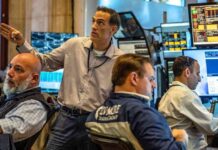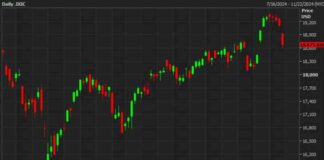Wall Street’s Perception Shift: From Cheering Bad Data to Emphasizing Strong Growth
The landscape of Wall Street has undergone a significant shift in recent weeks, as the traditional response to economic data has evolved. Previously, any signs of weakness in economic indicators were met with enthusiasm by investors, as it suggested a potential slowdown in inflation. However, the narrative has changed as a weakening labor market and cooling inflation have altered the perspective that took hold during America’s post-Covid boom.
The Federal Reserve, which had long focused on taming inflation as its primary mandate, has shifted its attention to rising risks to maximum employment, the second component of its dual mandate. This change in focus comes as markets brace for the Federal Reserve to initiate interest rate cuts for the first time in over four years next month.
Transition from Inflation to Labor Market Concerns
As the U.S. economy experienced robust growth in 2021, with an annual rate of nearly 7%, concerns about inflation started to loom large. The annual inflation rate surged from 1.4% to 7% throughout the year, peaking at 9.1% in June 2022, marking its highest level since the 1980s. In response to the escalating inflation, the Federal Reserve embarked on an aggressive campaign of interest rate hikes in March 2022 to prevent the economy from overheating.
Despite the Fed’s historical focus on inflation, the tight labor market also demanded attention. The Covid-induced economic downturn in March 2020 led to a temporary halt in hiring, but as the economy recovered and interest rates remained low, companies ramped up hiring efforts. Throughout 2021, employers added an average of 603,000 jobs per month, leading to a significant drop in the unemployment rate from 6.4% in January to 3.9% in December. However, even with the strong job growth, there were still over 12 million job openings in the U.S. in March 2022, nearly double the pre-pandemic levels.
The resilient labor market, characterized by robust wage growth and sustained consumer spending, became a key driver of economic growth. While signs of a weakening job market and a slower economy were initially viewed positively by the Fed and markets, the narrative has shifted as inflation concerns have taken a backseat to other economic indicators.
Changing Market Dynamics
Recent developments in the market have highlighted a shift in focus from inflation to growth data. Stocks experienced their worst day since 2022 in early August following a surprising jump in the unemployment rate in July, sparking fears of a potential recession. However, just days later, stocks rebounded as initial jobless claims came in lower than expected.
Inflation data, which previously drove market reactions, now takes a back seat to growth data. The S&P 500’s response to growth data has been more pronounced than its reaction to inflation data, signaling a new emphasis on economic expansion. According to analysts at Bank of America Securities, “Growth is in the driver’s seat,” reflecting the market’s shifting priorities.
The correlation between the S&P 500 and the Bloomberg U.S. Economic Surprise Index has oscillated between negative and positive over the past year. However, recent trends indicate a positive correlation, suggesting that good economic news is now perceived as positive on Wall Street. This change in correlation could indicate a shift in investor sentiment towards economic data.
Fed’s Focus on Labor Market Dynamics
The Federal Reserve’s evolving stance on economic indicators is reflected in its increasing focus on the labor market. In its June policy statement, the Fed acknowledged the uncertain economic outlook and emphasized inflation risks. However, the July statement signaled a shift in tone, highlighting the Committee’s attention to the risks associated with its dual mandate of inflation and employment.
The minutes of the Fed’s July meeting revealed growing concerns among officials regarding the state of the labor market. Participants noted the risks to achieving both inflation and employment objectives and acknowledged the need for a balanced approach. Fed Chair Jerome Powell’s remarks at the Jackson Hole Economic Policy Symposium further underscored the Fed’s shifting priorities, as he highlighted diminished inflation risks and increased concerns about employment.
Market Expectations Ahead of September Rate Cut
Wall Street’s anticipation of interest rate cuts has been a dominant theme throughout the year. However, as the Fed signals imminent rate cuts, investors are grappling with mixed emotions. While rate cuts may address concerns about the labor market, they also raise questions about the pace of economic slowdown.
Quincy Krosby, Chief Global Strategist at LPL Financial, points out the delicate balance between addressing labor market challenges and avoiding an economic downturn. The market seeks reassurance that the Fed will support economic growth while managing inflation. BofA analysts emphasize the importance of maintaining economic expansion without sacrificing inflation control, highlighting the need for a balanced approach from the central bank.
As the Fed evaluates incoming data, including inflation reports and the August jobs report, market volatility is expected to persist leading up to the Fed’s next meeting in September. The market’s response to the Fed’s policy decisions will depend on the central bank’s ability to navigate the complex interplay between inflation, employment, and economic growth.
In Conclusion
The recent shift in Wall Street’s perception of economic data reflects a changing landscape driven by evolving market dynamics and the Federal Reserve’s shifting priorities. While inflation concerns have dominated the economic narrative in recent years, a renewed focus on the labor market and economic growth signals a new chapter in the economic outlook.
Investors are navigating uncertainty as they anticipate the Fed’s upcoming rate cuts, balancing concerns about the labor market with the need for sustained economic expansion. The market’s response to the Fed’s policy decisions will be closely monitored in the coming months, as investors seek reassurance that the central bank will support economic growth while managing inflation risks.
As Wall Street continues to adapt to changing economic conditions, the ability to interpret and respond to evolving data will be crucial in navigating the complex financial landscape. The market’s resilience in the face of uncertainty will be tested as investors weigh the implications of the Fed’s policy decisions on economic stability and growth.

















